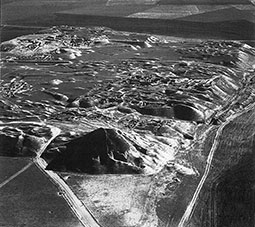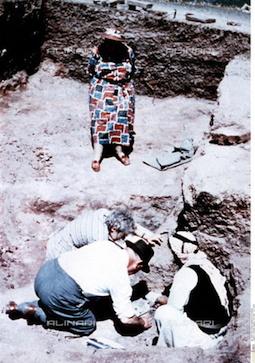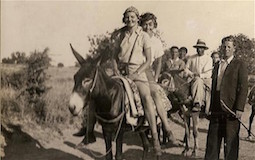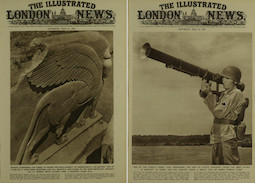Remnants of empire: views of Kalhu in 1950
By 1950, at last, serious investigations were underway to reveal the geography and history of the ancient city of Kalhu. Under the direction of Max Mallowan PGP the archaeological site of Nimrud was active again, for the first time in about a hundred years. Much had changed in attitudes and approaches over the past century but much had stayed surprisingly the same.
From empire to Mandate to quasi-independence

Image 1: Max Mallowan PGP and Agatha Christie PGP first visited Nimrud in 1931, while working on the British Museum's TT excavations at nearby Kuyunjik PGP (ancient Nineveh PGP ). At the centre of the photo, by dig director Reginald Campbell Thompson PGP , is his wife Barbara with Mallowan and Christie on either side. © British Museum. View this image on the British Museum's website.
Most notably, Nimrud was no longer in an inaccessible eastern province TT of the Ottoman empire TT , which had collapsed in the aftermath of World War I. The site was now off a well-travelled road in the modern state of Iraq. The country had been nominally independent from British Mandate TT rule for nearly two decades now but was still a monarchy headed by the overtly anglophile king Faisal II PGP . As recently as 1948 the Anglo-Iraqi Treaty TT —highly unpopular with many Iraqis—had formally renewed British influence over the country's military and foreign affairs, while the monopolistic Iraq Petroleum Company TT was Iraqi only in name. It was in fact registered in London and jointly owned by big western companies such as BP, Shell, and a consortium of American oil producers. Iraq was very much part of Britain's informal empire, and its archaeology was no exception.
Throughout the Mandate era of the 1920s and early 30s, the British had treated Iraqi archaeological sites as a resource to be exploited, not unlike oil (1). Yet throughout this period Nimrud had remained untouched (Image 1). The flagship British expeditions—both run in collaboration with wealthy American partners—were further south at Ur PGP and Kish PGP . Meanwhile in Assyria it was the tablet-rich TT site of Kuyunjik PGP , ancient Nineveh PGP , to which the British Museum returned. When Director of Antiquities Gertrude Bell PGP died in 1926 the British School of Archaeology in Iraq TT , BSAI, was set up in her memory and began operations in 1932.
The view from the mound

Image 2: Mallowan's stratigraphic TT excavation methods had long been normal archaeological practice and remain so today. Unlike Layard's PGP tunnelling they enable a clear view of the dig from the air, as shown by this photograph taken in the 1950s from the northwest of the mound (2). Photo: BSAI/BISI. View large image.
In 1950 the director of BSAI was Max Mallowan, Professor of Western Asiatic Archaeology at the Institute of Archaeology TT in London and husband of crime writer Agatha Christie PGP . The reasons he later gave for choosing Nimrud vary in their emphasis but the figure of Layard consistently looms large (3), (4). Crudely put, Mallowan wanted what Layard had got: not only the monumental finds but also the prestige that went with them. So in many ways the Nimrud expedition of 1948–60 was modelled quite explicitly on its century-old precursor. Excavation sites were chosen in order to recover more of Layard's glorious ivories, as well as the cuneiform TT tablets that had escaped him. But fortunately Mallowan was not entirely bound by Layard's legacy and sought to explore the citadel TT mound in much more modern ways as well, with all the tools of mid-century, large-scale archaeology at his disposal (Image 2).
Thus the ancient city of Kalhu began to emerge beyond the confines of the stone-lined walls that Layard's men had traced. A systematic survey TT mapped the entire citadel mound, while stratigraphic TT excavations of buildings revealed the Victorian burrowings of Layard and the sculpture hunters, as well as uncovering much more of the Northwest Palace. Elsewhere on the citadel, Mallowan's team brought to light city walls, private residences, administrative buildings and—for the first time—cuneiform tablets. This substantial archive of some 150 letters and records turned out to belong to the late 9th-century governor TT of Kalhu, one Bel-tarṣi-ilumma PGP . Mallowan's wide-ranging explorations, and integration of historical and archaeological data, brought into focus the ancient city of Kalhu itself for the very first time.

Image 3: In this rare colour photo, taken in 1956, Agatha Christie watches her husband Max Mallowan and colleagues remove a particularly delicate artefact from the ground at Nimrud. © Archiv Friedrich / Interfoto/Alinari Archives. View large image.
Much effort went into understanding of the evolution of the city—or at least the royal citadel—over the course of the early first millennium BC. However, Mallowan's Nimrud was strictly a window onto early Neo-Assyrian TT Kalhu. One early sounding reached 13th-century Middle Assyrian TT levels but was not pursued beyond the first season TT . Later in the 1950s, David and Joan Oates PGP were reprimanded for excavating post-Assyrian remains in the director's absence. In this way, and others, Mallowan maintained tight chronological controls on the meaning and value of the site.
Nimrud itself became a bastion of Britishness, with Mallowan forever hatted, suited, and upright—directing, rarely getting down into the dirt himself (Image 3). His wife Agatha Christie proved as big an attraction for British visitors as the site itself. Indeed, Mallowan was careful to portray Agatha as a key member of the team, knowing that her celebrity attracted publicity, sponsorship, and technical support from the Iraq Petroleum Company (5). Tea with Agatha was offered to IPC wives in exchange for the loan of heavy lifting and transport equipment. However, if Agatha and Max were the front-of-house representatives of the project, behind the scenes much of the real work was spearheaded by less glamorous Brits.

Image 4: In 1934 Barbara Parker PGP and Rachel Clay (later Rachel Maxwell-Hyslop PGP ) together made up 2/3 of the very first student intake of the Institute of Archaeology TT in London. They became lifelong friends and colleagues, and were key members of Mallowan's team at Nimrud. Here they are taking a break from excavation in Cyprus PGP in the late 30s, with Rachel on the front of the donkey and Barbara behind. © The Daily Telegraph. View this image in The Daily Telegraph's obituary of Rachel Maxwell-Hyslop.
Foremost amongst them was Barbara Parker PGP , Secretary/Librarian of the BSAI (Image 4). She not only oversaw the building of the archaeologists' dig house TT at Nimrud before excavations began but also did much of the on-site photography as work progressed. Her academic specialisms were in the cylinder seals TT and the legal and economic documents found on the citadel. Parker's low-key research publications did much to illuminate the mechanisms of Neo-Assyrian empire and society (6), (7), (8), (9), (10).
Another major difference from a century before was the formal involvement of Iraqi authorities and professional archaeologists. A division of finds TT was made each year by the Director-General of Antiquities TT , ensuring that the best discoveries remained in-country, whether on site, in the Iraq Museum TT or, later, at the museum in nearby Mosul PGP . And, as the expedition progressed, a team of Iraqi conservators TT moved in to prepare the site of Nimrud for future visitors, the restoration TT and excavation programmes sometimes hindering but often inspiring each other in unexpected ways.
International glimpses of Kalhu
Mallowan also followed Layard's lead in using choice objects, allocated to the BSAI in the formal division of finds, as incentives for sponsors. But the gifts were mostly of ivories, now, rather than bas-reliefs TT —and the recipients were museums and universities, rather than politicians and diplomats. While the dispersal of finds has created enormous headaches for subsequent generations of researchers, at mid-century, before mass travel and much mass media, it was an efficient and well-intentioned way of giving access to a little bit of Assyria to many more people than could ever reach Nimrud, Baghdad PGP or London. As Mallowan later put it:
The wise provisions of the Iraqi law at that time have allowed these two gems [i.e., the twin 'Ethiopian' ivories] to be distributed between two far distant capitals [i.e., London and Baghdad]: there could in this dangerous age be no better insurance against the total loss and destruction of both, and no better way of allowing the East and West to enjoy them (11).
The view from the press

Image 5: On 22 July 1950 The Illustrated London News led with a photo of an "11 foot monster", "winged, harnessed and posed to guard the king's majesty of Assurnasirpal the second PGP " from "the most important Assyrian dig at Nimrud since Layard's time" (12). The following week, nostalgia for empire was replaced by a striking image of "one of the world's finest tank destroyers: a US bazooka on deployment in Korea (13). News from Nimrud was relegated to the back pages of the paper. © Gale. View large image.
For academic audiences, Mallowan and his team published preliminary reports in BSAI's biannual journal Iraq, published back in London. But in presenting his finds to a wider public he deliberately emulated Layard by writing for the now somewhat old-fashioned Illustrated London News TT . A more up-to-date choice might have been the Picture Post TT , for instance, that was started in the late 1930s. Like Layard, he placed pieces in two or three issues a year for almost every year of the excavation. In 1950, however, the emphasis was on finds in the field, rather than arrivals in the British Museum, and photography allowed a far greater emphasis on artefacts, buildings and the archaeological process than had been possible in Layard's day.
While Layard's Nimrud was packaged as an extension of Dickensian PGP Christmas jollity, Mallowan's Nimrud of 1950 was juxtaposed with terrifying images of the Korean War TT (Image 5). Victorian Britons could celebrate Assyria as an ancient allegory of Pax Britannica, imperiously self-confident. Just five years after the end of World War II, however, at a time of waning British power, Assyrian imperialism took on a more sinister hue (14), (15).
A winged lion graced the front cover of the ILN on 22 July 1950, "guard[ing] the king's majesty of Assurnasirpal the second PGP " while the following pages covered various aspects of royal pageantry in contemporary Britain. Nimrud was still as it always had been, a familiar part of the extended British empire. The next week, however, there was no escaping the new realities of warfare: an enormous bazooka dominated the front cover, while massed American tanks loomed over a symbolically fallen winged bull. An allegory for Britain's newly reduced status in the world, if ever there was one, just a year after the formal creation of the self-governing Commonwealth out of the ashes of the former British empire.
References
- Bernhardsson, M., 2005. Reclaiming a Plundered Past: Archaeology and Nation Building in Modern Iraq. Austin: University of Texas Press. (Find in text ^)
- Oates, D. and J. Oates, 2001. Nimrud, An Assyrian Imperial City Revealed, London: British School of Archaeology in Iraq ( free PDF from BISI, 128 MB), pp. 105, Fig. 63. (Find in text ^)
- Mallowan, M.E.L., 1966. Nimrud and Its Remains, vols. I-II, London: Collins, pp. I 13. (Find in text ^)
- Mallowan, M.E.L. 1977. Mallowan's Memoirs, London: Collins, pp. 241-3. (Find in text ^)
- Trümpler, C. (ed.), 2001. Agatha Christie and Archaeology, London: British Museum Press (English edition). (Find in text ^)
- Parker, B., 1954. "The Nimrud tablets, 1952: business documents", Iraq 16, pp. 29-58 (PDF available via JSTOR for subscribers). (Find in text ^)
- Parker, B., 1955. "Excavations at Nimrud, 1949-53: seals and seal impressions", Iraq 17, pp. 93-125 (PDF available via JSTOR for subscribers). (Find in text ^)
- Parker, B. 1957. "Nimrud tablets, 1956: economic and legal texts from the Nabu Temple", Iraq 19, pp. 125-138 (PDF available via JSTOR for subscribers). (Find in text ^)
- Parker, B. "Administrative tablets from the North-West Palace, Nimrud", Iraq 23 (1961): 15-67 (PDF available via JSTOR for subscribers).. (Find in text ^)
- Parker, B. "Seals and seal impressions from the Nimrud excavations, 1955-58", Iraq 24 (1962): 26-40 (PDF available via JSTOR for subscribers). (Find in text ^)
- Mallowan, M.E.L. 1977. Mallowan's Memoirs, London: Collins, p. 261. (Find in text ^)
- The Illustrated London News, 22 July 1950, p. 121. (Find in text ^)
- The Illustrated London News, 29 July 1950, p. 163. (Find in text ^)
- The Illustrated London News, 22 July 1950. (Find in text ^)
- The Illustrated London News, 29 July 1950. (Find in text ^)
Further reading
- Mallowan, M.E.L., 1966. Nimrud and Its Remains, vols. I-II, London: Collins.
- Mallowan, M.E.L. 1977. Mallowan's Memoirs, London: Collins.
- McCall, H., 2001. The Life of Max Mallowan: Archaeology and Agatha Christie, London: British Museum Press.
- Trümpler, C. (ed.), 2001. Agatha Christie and Archaeology, London: British Museum Press (English edition).
Eleanor Robson
Eleanor Robson, 'Remnants of empire: views of Kalhu in 1950', Nimrud: Materialities of Assyrian Knowledge Production, The Nimrud Project at Oracc.org, 2019 [http://oracc.museum.upenn.edu/nimrud/modernnimrud/onthemound/1950/]